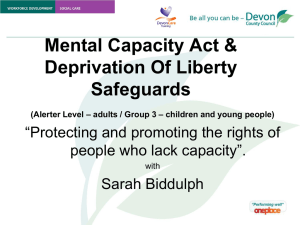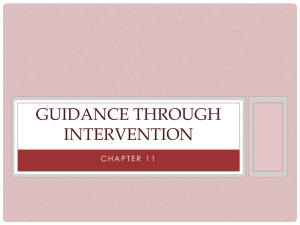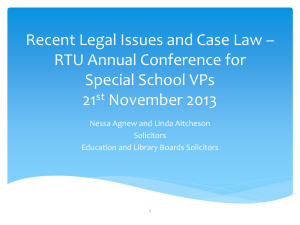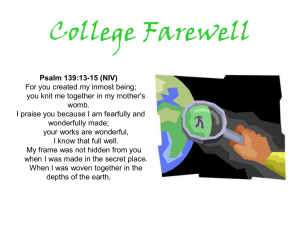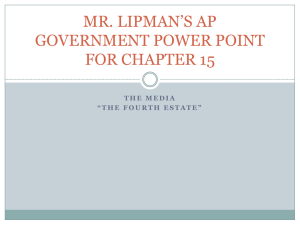Go to publication
advertisement
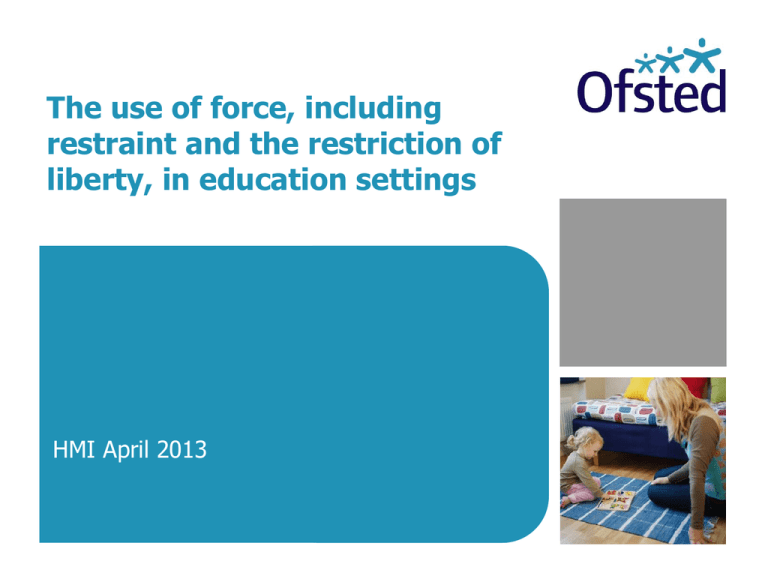
The use of force, including restraint and the restriction of liberty, in education settings HMI April 2013 Reasons for this training There is an increasing number of complaints about potentially inappropriate use of force and restraint including restriction of liberty within education settings. The session aims to increase your confidence and knowledge about the difference between what is acceptable force and what is unacceptable in a variety of situations. The session aims to ensure inspectors have a better understanding about when they need to make a judgement and report on the use of force within education settings and also when to refer issues to the Compliance, investigation and enforcement team (CIE). The use of force, including restraint and the restriction of liberty April 2013 The Use of Reasonable Force Advice for headteachers, staff and governing bodies Non-statutory guidance, DfE (2012) What is reasonable force? Force is usually used either to control or restrain - ranging from guiding a pupil to safety by the arm to break up a fight or where a student needs to be restrained to prevent violence or injury. ‘Reasonable in the circumstances’ means using no more force than is needed. Control means either passive physical contact, e.g. standing between pupils or blocking a pupil's path, or active physical contact such as leading a pupil by the arm out of a classroom. Restraint means to hold back physically or to bring a pupil under control. School staff should always try to avoid acting in a way that might cause injury, but in extreme cases it may not always be possible to avoid injuring the pupil. The use of force, including restraint and the restriction of liberty April 2013 When can reasonable force be used in schools? To prevent pupils from hurting themselves or others, from damaging property, or from causing disorder. Whether or not to physically intervene is a professional judgement dependent on the individual circumstances. The use of force, including restraint and the restriction of liberty April 2013 4 When can reasonable force be used? Examples include: removing disruptive children from the classroom where they have refused to follow an instruction to do so preventing a pupil behaving in a way that disrupts a school event or a school trip or visit preventing a pupil leaving the classroom where allowing the pupil to leave would risk their safety or lead to behaviour that disrupts the behaviour of others preventing a pupil from attacking a member of staff or another pupil, or to stop a fight in the playground restraining a pupil at risk of harming themselves through physical outbursts. The use of force, including restraint and the restriction of liberty April 2013 5 When can reasonable force be used in FE? Members of staff in an institution which is within the further education sector may use force as is reasonable in the circumstances to prevent a student at the institution from doing or continuing to do any of the following: committing an offence cause personal injury to, or damage to the property, of any person (including the student himself) prejudicing the maintenance of good order and discipline at the institution or among any of its students, whether during a teaching session or otherwise. This power may be exercised both on the institution’s premises or elsewhere when the member of staff has lawful control or charge of the student. The use force to control or restrain in further education settings Joint publication DfES and AoC The use of force, including restraint and the restriction of liberty, in education settings 04 2013 6 When can reasonable force be used? Discuss what evidence you would want to explore to ensure the staff at the school or college had a clear and consistent interpretation of reasonableness. The use of force, including restraint and the restriction of liberty April 2013 Unacceptable techniques The following restraint techniques present unacceptable risk and must not be used: the ‘double basket hold’ which involves holding a person’s arms across their chest’; the ‘seated double embrace’ involves two members of staff forcing a person into a sitting position and leaning them forward, while a third monitors breathing; and the ‘nose distraction’ technique which involves a sharp upward jab under the nose. The use of force, including restraint and the restriction of liberty April 2013 Other key points There is no requirement to have a policy on the use of force but schools must have a behaviour policy. It is good practice for this to set out the school’s approach to the use of force. Schools should not have a ‘no contact’ policy. Any policy should acknowledge the school’s legal duty to make reasonable adjustments for disabled children and pupils with special educational needs. The use of force, including restraint and the restriction of liberty April 2013 Other key points Schools should decide whether any members of staff need additional training to carry out their responsibilities, taking account of the needs of its pupils. Schools do not require parental consent to use force. It is good practice for schools to speak to parents about serious incidents involving the use of force and to consider how best to record such serious incidents. It is up to schools to decide whether it is appropriate to report the use of force to parents. The use of force, including restraint and the restriction of liberty April 2013 Power to search pupils without consent In addition to the general power to use reasonable force described above, head teachers and authorised staff can use such force as is reasonable given the circumstances to conduct a search for the following “prohibited items”: knives and weapons alcohol illegal drugs stolen items tobacco and cigarette papers fireworks pornographic images any article that has been or is likely to be used to commit an offence, cause personal injury or damage to property. Force cannot be used to search for items banned under the school rules. The use of force, including restraint and the restriction of liberty April 2013 Who can use reasonable force? All members of school staff have a legal power to use reasonable force. This includes any people whom the headteacher has temporarily put in charge of pupils – such as unpaid volunteers or parents accompanying pupils on a school organised trip. It is always unlawful to use force as a punishment. The use of force, including restraint and the restriction of liberty April 2013 Time-out - the restriction of access to all positive reinforcements as part of a planned and structured behavioural programme. Withdrawal - the removal from a situation which causes anxiety or distress to a location where the pupil can be continuously observed and supported until ready to resume usual activities. The location may also be called a relaxation room. Internal exclusion – The most common use in schools is to describe the removing a pupil from normal timetabled lessons and their placement in supervised education in a separate room, sometimes with a small number of other pupils. It can be an alternative to fixed term exclusion. It is sometimes mistakenly called ‘seclusion’ but this means forcing a child to spend time alone against their will. The use of force, including restraint and the restriction of liberty April 2013 It is an offence to lock a person in a room without a court order except in an emergency, for example where the use of a locked room is a temporary measure while seeking assistance. The use of force, including restraint and the restriction of liberty April 2013 Inspectors should consider: If the use of force was reasonable If the use of force is part of a planned strategy, or a response to an emergency/safety situation the extent to which the focus of the strategy is on the prevention of the need for the use of force the quality of the behaviour and risk assessment that takes into account the individual needs of the young person the effectiveness of the strategy – for example in terms of frequency and duration of use the reasonableness of the use of force The use of force, including restraint and the restriction of liberty April 2013 Guidance on the use of restrictive interventions for staff working with children and adults who display extreme behaviour in association with learning disability and/or autistic spectrum disorders’ (DfES 2002) (also called ‘Guidance for restrictive physical interventions: How to provide safe services for people with learning disabilities and autistic spectrum disorders’ (DH 2002) Wide ranging guidance including prevention and risk assessment, recording, post-incident management, staff training. Page 5 provide a good outline of contents of records The use of force, including restraint and the restriction of liberty April 2013 Guidance on the use of restrictive physical interventions for pupils with severe behavioural difficulties (DfES, 2003) Guidelines to provide practical advice for local authorities and special schools on policies and risk assessment. The use of force, including restraint and the restriction of liberty April 2013 Reporting concerns Inspectors must refer the information to Ofsted’s compliance, investigation and enforcement (CIE) team if the setting’s approach to the management of children and young people’s behaviour is considered not to be appropriate, including the use of the unacceptable techniques, and may place them at risk. Social care inspectors must also inform their inspection team manager. The CIE team may arrange for a case review to consider the risk to children and young people, and whether the setting is failing to safeguard and protect them from harm. The case review would consider the most appropriate next step to take, including whether the need to initiate child protection procedures. The use of force, including restraint and the restriction of liberty April 2013

